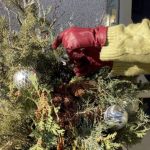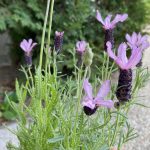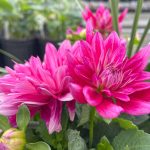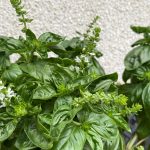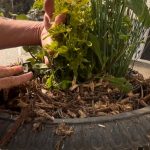Poinsettias are often used as living decorations during the holidays and composted once they start looking shaggy. If this is a path that grinds against the gardener in you, there is another way!
Let’s talk about how to care for Poinsettias through the year and get them to bloom for next Christmas.
Learn how to care for Poinsettia through the year and how to get a Poinsettia to flower in time for Christmas.

How to Care for Poinsettias as a Houseplant
Knowing where plants come from is beneficial to give us clues for their care. Poinsettias are from tropical areas of Central America and Mexico where the year-round temperatures stay well above 16° Celsius, the humidity hovers at 80%, and the topsoil layer is thin.
The trick for plant longevity is to mimic the conditions Poinsettias originate from as best we can so they can grow in our colder, drier, North America.
Water Poinsettias Only When Necessary
As mentioned above, the topsoil layer in the tropics is thin and porous with a lower water holding capacity than typical prairie soils. As a result of, or in response to these conditions, Poinsettias have a shallow and often fragile root system.
In a home or office setting, if your Poinsettia has a foil cover over the bottom of the pot, remove the foil, and place a saucer beneath it so excess water can drain out because Poinsettias are very susceptible to root rot.
Therefore, it is essential for Poinsettias to grow in soil that drains well; if the roots are exposed to wet conditions for too long, root rot will settle in.
It’s better to keep your Poinsettia on the drier side, but it’s unhealthy to dry them to a state of completely wilting. As soon as you see the leaves begin to flag, water it right away. Flagging is a horticultural term used for wilting, like a flag hanging on a flagpole.
Poinsettias will also start to look wilted if they are overwatered and as the roots become compromised. The pot will feel heavy because of the high water content in the soil, and it will make you wonder why it’s wilted.
This ‘flagging wilt’ look is a Poinsettia’s universal sign expressing stress. They will wither if they are too cold, have been frozen, or if they are too hot, as well. If root rot has begun, it’s hard to reverse. Let the soil dry down and see if the flagging resolves. If the wilting worsens, sadly the Poinsettia is toast.
To avoid root rot in a Poinsettia, always check its soil before watering. You can do this by assessing the pot’s weight or by sticking your index finger into the earth to the depth of your second knuckle. If the container is light or if the soil is dry at the tip of your index finger, it’s time to water.
As with any houseplant, metabolic activity drops during the winter months and their need for water decreases. You will get used to the rhythm of how often your Poinsettia needs watering in your location. For example, in the central Alberta region, you may find that a Poinsettia in a pot with a 6″ diameter only needs to be watered every 7 to 14 days.
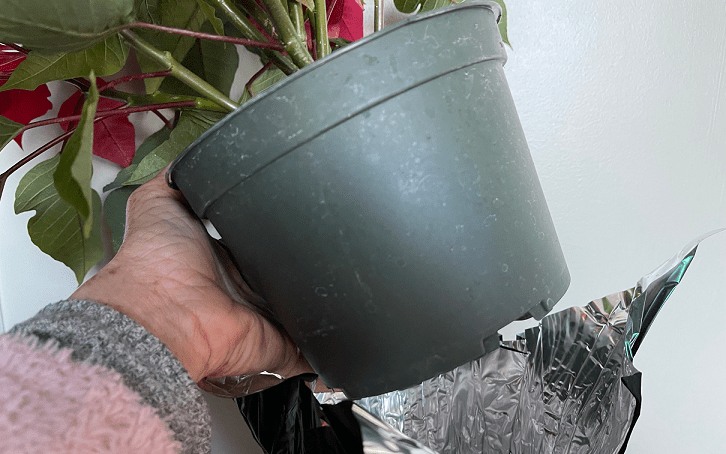
Two Different Methods to Watering a Poinsettia:
1. Water the Poinsettia from the Bottom
Let the Poinsettia soak in a bowl of clear water to take water up through the roots. Let it sit in the water for 20 minutes and drain following.
2. Water the Poinsettia at Base of the Stem
Water gently, with a watering can or something with a spout, at the base of the stem. Do your best to keep the leaves dry because damp leaves can lead to various fungal infections.
How to Fertilize Poinsettias Throughout the Year
Poinsettias will do well with fresh, clear water until the bracts have faded back to their green colour.
The red colour (or white or coral or pink) we associate with Poinsettias isn’t their actual flower. These coloured leaves are called bracts.
Bracts are modified leaves typical of the Euphorbia family that turn colour when a plant is about to bloom. The true flowers are tiny structures in the center of the coloured bracts. The purpose of the bracts is to attract pollinators to fertilize the flowers.
When the bracts have turned green, start fertilizing once a month with a water-soluble balanced fertilizer like 20-20-20 or 10-10-10. Dilute the fertilizer to 1/2 strength until they start actively growing as the weather warms.

Providing the Right Growing Environment for Poinsettias Through the Year
I’ve said it before, and I will say it again, Poinsettias are the quintessential Goldilocks plant.
Poinsettias hate temperature extremes on either end of the spectrum.
Dry conditions like air heating vents and fireplaces will cause them to dry out rapidly, and their leaves will desiccate. Other symptoms of dehydration include leaf tips turning from light green to yellow and then brown, culminating with the whole leaf curling and crisping like a potato chip.
Cold winter air coming in through leaky windows and door entries will also affect Poinsettias. When exposed to cold air, their leaves will look — you guessed it — wilted. When they wilt, we tend to water them, which can start a cycle of overwatering. Move the Poinsettia to a warmer location, and it should perk up.
Keep Poinsettias in indirect light with some direct sunlight. Keep an eye on the direct sunlight, as windows can magnify light rays and scorch Poinsettia leaves. Watch for sunscald as the sun gets closer and brighter in the spring. Pale and burned leaves are symptoms.
Poinsettias grow well outdoors during the summer. Place them in an area where they can get 6-8 hours of direct sun exposure. Morning sunlight, or an eastern facing location, is great because the sun is less intense during the early hours of the day. When the sun is scorching during the middle of the day, the Poinsettia will be safe in the shade.
Watch temperatures as the days and evenings cool in mid-August. Bring the Poinsettia indoors to avoid cold stress when the overnight lows dip to 16° C or the mid 60°s Fahrenheit.
How to Trim Poinsettias for Optimal Growth

Poinsettias are tropical shrubs that can grow up to 13 feet tall, which explains why they have a natural tendency to get gangly or a little wild in their growth pattern.
This is typical of Poinsettias, and they will stretch if light levels are low and there is little air movement in their growing environment.
You can keep this growth under control by pinching the plant back once the bracts have returned to green and the tiny flowers have died. Cut it back 1/3 or by even as much as to half its size. Cut the branches back just above a leaf node. Leaf nodes are intersections where leaves emerge from a stem.
Pinching back sounds and looks a little scary, but the Poinsettia will branch out and grow stocky. As it grows, don’t be shy about pinching or trimming it back a little to help retain a pretty shape.
Pinching Poinsettias back will keep them bushy and robust.
As your Poinsettia grows quite large, it’s a good idea to replant them in a larger pot to allow wiggle room for growth. Plant the Poinsettia in high quality potting soil that will provide water retention and good drainage.
How to Get a Poinsettia to Turn Colour and Rebloom in Time for Christmas
Poinsettias are short day plants that flower in response to photoperiod.
Poinsettias bloom just in time for Christmas in their natural tropical environment as they experience 12-14 hours a day of complete darkness. In the tropics, this cycle starts at the beginning of September.
Home-grown Poinsettias need the same thing: 12-14 hours of complete, uninterrupted darkness for 2 months to initiate flowering. Any amount of light, even small amounts of light, will mess up their timing.
Starting at the end of August or the beginning of September, a Poinsettia needs 12-14 hours of total darkness and 10-12 hours of light.
When we grew them in our family greenhouse, the meagre light of a Coke machine would delay their flowering, so it had to be unplugged for the Poinsettias to have complete darkness.
About 6 weeks in this lighting cycle, you should see the bracts beginning to change colour.
How can you achieve the right darkness conditions for a Poinsettia in an average home?
Here are some ideas:
- The best idea I’ve seen comes from Larry Hodgson, a prolific Canadian gardening writer, in his blog called Getting Your Poinsettia to Rebloom The Easy Way – Laidback Gardener. Larry suggests placing the Poinsettia in a spare room that gets natural light during the day and is dark at night. Here’s the trick: Unscrew the light bulbs. With the light bulbs unscrewed, you won’t accidentally expose the Poinsettia to bright light if you enter at night.
Position the Poinsettia away from any window with bright light filtering in from outside.
- If you don’t have a spare room:
- You could place the Poinsettia in a closet at night, being sure to block any light that may leak in under the door with something like a towel.
- Place the Poinsettia in a cardboard box that will stop any light from coming in during the night. This may warrant a blanket to cover the top to prevent light from coming through any cracks.
Sounds a bit ominous? It does, but you can do this — it’s only for 2 months. Setting an alarm to keep you on track will be helpful.
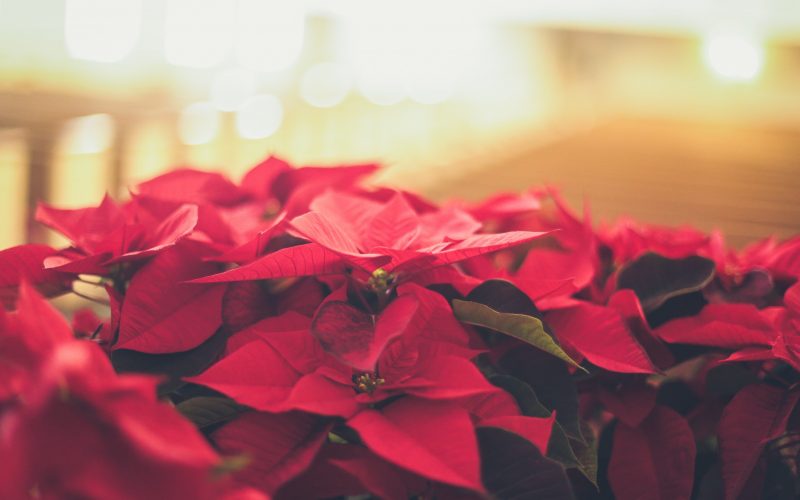
You’ve Got This!
Growing Poinsettias is a unique journey. They have specific needs because of their tropical roots — literally.
I want to encourage you to give growing Poinsettias a try; they will elevate your skills as a home grower and getting them to bloom will make you feel great! And an added bonus, the Christmas holidays will be beautiful.
If you master growing Poinsettias and keeping them healthy year round, you’ll be able to save yourself from buying them year after year as well as keep a beautiful plant in your home all year round! Once Christmas rolls around again or you need some additional pointers, you can reference my other blog on Caring for Poinsettias in 3 Simple Steps.
©Sharon Wallish Murphy ©Gardening with Sharon


